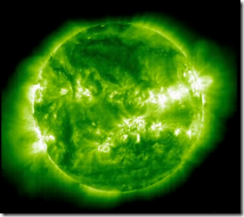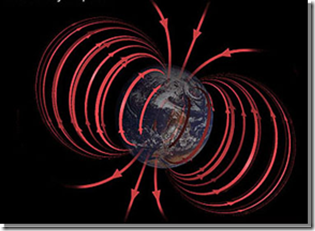During the end of January the Sun went through a period of intense activity. The sunspot group 1402 has issued a solar flare with an associated CME that reached the Earth. As we have seen in solar particles these events cause the so-called solar particle events (SPEs). I was invited to speak about the nature of these events and their potential effects on safety for astronauts during the Italian podcast named AstronautiCAST (you can download the episode here). I would like to deepen the topic even here on the blog. We already talked about the solar cycle, sunspots, flares and CME, but how are they correlated and what are their differences?
Let’s start from the structure of the Sun. The Sun is a main sequence star with a mass of 2 × 1030 kg (representing alone 99.8% of the mass of the solar system) essentially made of hydrogen (74%) and helium (25%). Since the Sun doesn’t have a solid surface, but it is in a plasma state, it is subjected to a differential rotation: it rotates faster at the Equator than it does at the poles. The rotation period varies between 25 days of the Equator and 35 of the poles.
The differential rotation of the Sun is at the base of the solar cycle. The solar magnetic field (strongly coupled with the plasma of the photosphere) is warped by the differential rotation and while the solar cycle progresses it is increasingly twisted around the star. During solar minimum the magnetic field configuration is described by phase 1 of the figure, while during solar maximum the magnetic field looks like phase 3.
In this configuration, in which the field is heavily twisted, the field itself can form loops above the photosphere. At the points where the field emerges from the surface it inhibits the heat flow and it produces sunspots, which are colder than normal and are observed in pairs. This process continues until the magnetic dipole is totally destroyed and the polarity of the magnetic field is reversed. For this reason it is more correct to say that the solar cycle lasts 22 years (rather than 11) because this is the time that the magnetic field takes to return to the initial configuration with the Poles not reversed.
This behavior is evident in the following images of quiet Sun and active Sun (false-color image of the radio emission from the Sun’s Very Large Array radio telescope). The most intense points correspond to sunspots (source: NRAO solar radio emission).


These are other pictures where you can clearly see how sunspots show the underlying structure of the magnetic field.
This mosaic of images from NASA’s SOHO footage in extreme ultraviolet (source: http://www.astronet.ru/db/xware/msg/1224916) shows the connection between solar cycles and sunspot number.

The increased intensity of the solar wind during periods of maximum solar also reduces the flow of galactic cosmic rays with energies below 1 GeV/n.
After seeing what sunspots are, let’s describe the solar flares. The solar flares are huge explosions occurring in the solar atmosphere. The effect of flares is a sudden acceleration of particles, plasma heating up to tens of millions of degrees and the expulsion of huge quantities of solar mass. The flares are classified as A, B, C, M or X depending on their x-ray brightness near the Earth, measured in Watts/m². Each class is ten times more powerful than the previous one, with X (the largest) equal to 1012 W/m² and is divided by 1 to 9 linearly, and then a X2 is four times more powerful than an M5. Solar activity is normally between classes A and C.
There are two main types of flares: impulsive flares and gradual flares.
The impulsive flares mainly accelerate electrons with small amount of protons. Their duration ranges from a few minutes up to a few hours, and the majority comes from regions near the equator.
The gradual flares accelerate protons and nuclei up to speed the coming of light. They occur mainly in regions near the poles.
Below there is the video of the recent January 22 activity. It is very interesting to note how in the region concerned by the flare the magnetic field structure that emerges from the photosphere is clearly visible. In this video, as in other photos, the loops leaving the solar surface are due to the emission of particles of plasma that spiral along the lines of the field, making it visible.
The particles accelerated by flares end up in solar cosmic rays, also known as SEP (solar energetic particles). Solar particle events (SPEs) are defined by the number of protons. Important events show a total proton fluence over 30 MeV greater than 106/cm2. There are about 50 events of this intensity for each solar cycle. Major events have a fluency of protons over 10 MeV greater than 1010/cm2. There are about one or two events of this type for each cycle. Solar particle events associated with flares have up to 30 degree spatial extension.
The CME (coronal mass ejection) are, as the name implies, massive emissions of coronal mass that consists mostly of plasma of protons and electrons. The plasma transported along the magnetic field in the interplanetary space is going to interfere with the planetary magnetic fields encountered along the way. As we already saw, Earth’s magnetic field is deformed by this interaction and a CME can distort it and lower its ability to deflect the cosmic rays (technically, the geomagnetic cutoff is lowered). The energetic particles are also channeled along the field lines reaching low altitudes to form Aurora Borealis. The angular extent of a CME can reach up to 180 degrees sweeping practically half of the plane of the solar system. The speed of propagation of particles of this latest CME was estimated to be 2200 Km/s.
In the following video you can see, at 7th second, the recent CME observed with a coronagraph. Look at the extension of the phenomenon as well as the first relativistic particles that arrive on the sensor of the coronagraph displayed as white streaks.
In the following video, from 00:33 time, a graphical representation of the propagation of a CME in interplanetary space is shown.
Recent studies show that solar flares and CMEs might have a common origin from the phenomenon of magnetic reconnection. Magnetic reconnection is the rearrangement of field lines when two opposing magnetic fields are placed in contact. This rearrangement is accompanied by the sudden release of the energy stored into the two opposing fields.
In the Sun the magnetic field loops that protrude from sunspots can extend over to the point where the lines are reconnected in lower height loops, leaving a magnetic field bubble disconnected from the rest of the loop. The sudden release of energy causes the blasting while the magnetic field and the plasma of protons and electrons contained in the projected bubble expands outwards violently giving rise to CME.
After describing the various physical phenomena that lie behind those commonly known as solar storms, let’s see whether and how these events may be hazardous to the safety of astronauts. While the geomagnetic field protects space crews in LEO orbit from solar events, this protection is not available during an interplanetary trip outside the magnetosphere. The flow of protons during a trip to the Moon or to Mars would be similar to the one measured by geostationary satellites of the GOES series. One of the largest SPE recorded in August 1972 occurred between two missions, Apollo 16 and Apollo 17. If there was an Apollo capsule in a journey to the Moon during this event the astronauts would go through a potentially lethal acute radiation syndrome. During the solar event in October 1989, the Shuttle mission STS-34 was in a slightly tilted (34°) orbit to launch the Galileo spacecraft to Jupiter. Due to the low inclination of the orbit, the protection of the geomagnetic field was enough not to measure any increase in dose during this mission. Meanwhile, aboard the MIR space station, the dosimeter R-16 measured 40 mGy during the events of September and October 1989, equivalent to 100 days of normal exposure on MIR.
I want to end this post with a video responding to various fantasies of conspiracy involving this increased solar activity and the Mayan prophecies about the end of the world in 2012. There are even rumors that NASA has admitted these correlations and has foreseen that during 2012 super solar storms will blow technological civilization away from the face of the Earth. NASA would have also sent an email to employees saying to stay ready.
Here is what NASA thinks: "This solar cycle that will culminate in 2014 isn’t going to be significantly different from the next one, and the next one and the previous one. We always have solar flares. Some times we have big ones, some times we have small ones. Even the most powerful solar event of the last 10000 years could not damage the atmosphere (and the geomagnetic field) so that we are no longer protected. CMEs are happening on the sun all the time and they hit the Earth once or twice a week and in general the effects are minimal. Very powerful ones produce very intense auroras and can have effects on satellites and power grids, but these are the kind of things that people who run these systems know about. And we have warning, since these CMEs can take 2 or 3 days to reach the ground, and we can therefore take appropriate measures to prepare for them. We understand the Sun quite well and we have many spacecrafts that are monitoring it 24 hours a day, 7 days a week, to know that this super storm that is going to wipe out the Earth simply isn’t going to happen."
Sources and further reading:
NASA’S Cosmicopia – Solar activity
http://helios.gsfc.nasa.gov/cme.html
http://it.wikipedia.org/wiki/Sole
Solar Flares and Magnetic Reconnection (ppt)
Observations on Current Sheet and Magnetic Reconnection (ppt)
Space radiation dosimetry in low-Earth orbit and beyond (Benton, 2001)

















